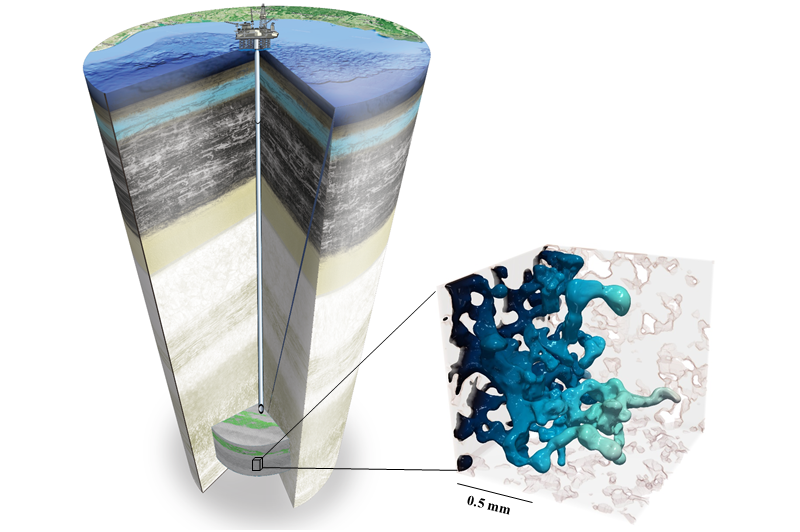The path to a stabilized climate is arduous and combative. Several solutions are required to enable a rapid, equitable shift away from fossil fuels: among them are the development of greener materials, sustainable energy sources and approaches to eliminate CO₂ from the air.
 Subsurface CO2 storage. Right: CO2 migration pattern in a digitized rock sample obtained from pore-scale two-phase flow simulation. The simulation was carried out on the Frontera supercomputer. (Image Credit: University of Texas).
Subsurface CO2 storage. Right: CO2 migration pattern in a digitized rock sample obtained from pore-scale two-phase flow simulation. The simulation was carried out on the Frontera supercomputer. (Image Credit: University of Texas).
One of the removal techniques researchers are investigating is called carbon capture and storage (CCS). In CCS, CO₂ is trapped from industrial sources and introduced into deep geological reservoirs underground, tentatively for thousands of years, in quite the same way as water is stored in aquifers.
Sahar Bakhshian, a researcher at the University of Texas at Austin's Bureau of Economic Geology, recently made use of the supercomputers at the Texas Advanced Computing Center (TACC) to basically comprehend how CO₂ storage occurs at the level of micrometer-wide pores in the rock, and to establish the features and factors that can help improve how much CO₂ can be stored.
Bakhshian investigated the capturing efficiency of CO₂ by dissolving the gas into the resident brine in saline aquifers. She published her findings in the International Journal of Greenhouse Gas Control (December 2021 issue).
We tried different scenarios—using different injection rates and fluid-rock properties—to determine how the properties affect what percentage of injected CO₂ can ideally be trapped by the dissolution mechanism.
Sahar Bakhshian, Researcher, Bureau of Economic Geology, University of Texas at Austin
She learned that two factors significantly affected the amount of CO₂ that could be injected into the spaces within the rocks: wettability (or how well CO₂ molecules adhere to the surface of the rock); and injection rate (the speed at which supercritical CO₂ is forced into the reservoir).
Another operational process that guarantees the security of CO₂ storage is capillary trapping, which occurs when CO₂ pinches off and becomes restrained in the pore space by capillary forces.
In another research paper published in Advances in Water Resources in April 2019, Bakhshian demonstrated the results of pore-scale, two-phase flow simulations that used digital forms of real rocks from a CO₂ storage test-site in Cranfield, Mississippi to investigate how CO₂ traveled through the pore structure of the rock during the injection process and how it can be captured as immobilized blobs in the pore space during post-injection.
Bakhshian's study is done under the support of the Gulf Coast Carbon Center (GCCC), which has been involved in understanding the potential, risks and suitable approaches for geologic carbon storage since 1998.
Supercomputers are one of the main tools that geoscientists exploit to study processes applicable to carbon capture and storage, according to Bakhshian.
"Computational fluid dynamics techniques are essential for this field, to better screen suitable target reservoirs for CO₂ storage, and predict the behavior of CO₂ plumes in these reservoirs," she said.
Understanding the dynamics of storage capacity at the level of the pore through high-performance computing simulations provides one lens into how carbon capture and storage could be achieved on a large scale.
Our research is basically trying to characterize geologic settings suitable for storage and exploring the way we inject CO₂ to make sure it's safe, effective, and poses no threat to people or groundwater resources.
Sahar Bakhshian, Researcher, Bureau of Economic Geology, University of Texas at Austin
Another facet of Bakhshian's study involves using machine learning methods to create computationally fast models that can approximate the storage capacity of reservoirs and help with the environmental tracking of CO₂.
Bakhshian suggested a deep learning framework to identify irregularities in soil gas concentration sensor data. The model was trained on data obtained from sensors being used for environmental description at a prospective CO₂ storage site in Queensland, Australia. Her findings have been reported in Environmental Science and Technology (October 2021 issue).
Bakhshian's technique, which integrates processes established on natural soil respiration into a deep learning framework, could detect irregularities in the sensor data that, in future applications, could signify either leakages or sensor errors.
Having a trustworthy real-time anomaly detection framework that is trained using the streaming sensor data and guided by a process-based methodology could help facilitate environmental monitoring in future projects.
Sahar Bakhshian, Researcher, Bureau of Economic Geology, University of Texas at Austin
Based on a report from the Global CCS Institute, the United States is one of the countries with the maximum potential for geologic CO₂ storage. Though some environmentalists debate that CCS is just a way for energy companies to pursue the extraction of fossil fuels, others, including the International Panel on Climate Change, include CCS as one of the ways the international community can accomplish net-zero emissions by mid-century.
"It's safe and effective," said Bakhshian. "And computing will help us find economical ways to achieve this goal."
Journal References:
Bakhshian, S. & Romanak, K. (2021) DeepSense: A Physics-Guided Deep Learning Paradigm for Anomaly Detection in Soil Gas Data at Geologic CO2 Storage Sites. Environmental Science and Technology. doi.org/10.1021/acs.est.1c04048.
Bakhshian, S. (2021) Dynamics of dissolution trapping in geological carbon storage. International Journal of Greenhouse Gas Control. doi.org/10.1016/j.ijggc.2021.103520.
Bakhshian, S. & Hosseini, S.A. (2019) Pore–scale analysis of supercritical CO2–brine immiscible displacement under fractional–wettability conditions. Advances in Water Resources. doi.org/10.1016/j.advwatres.2019.02.008.